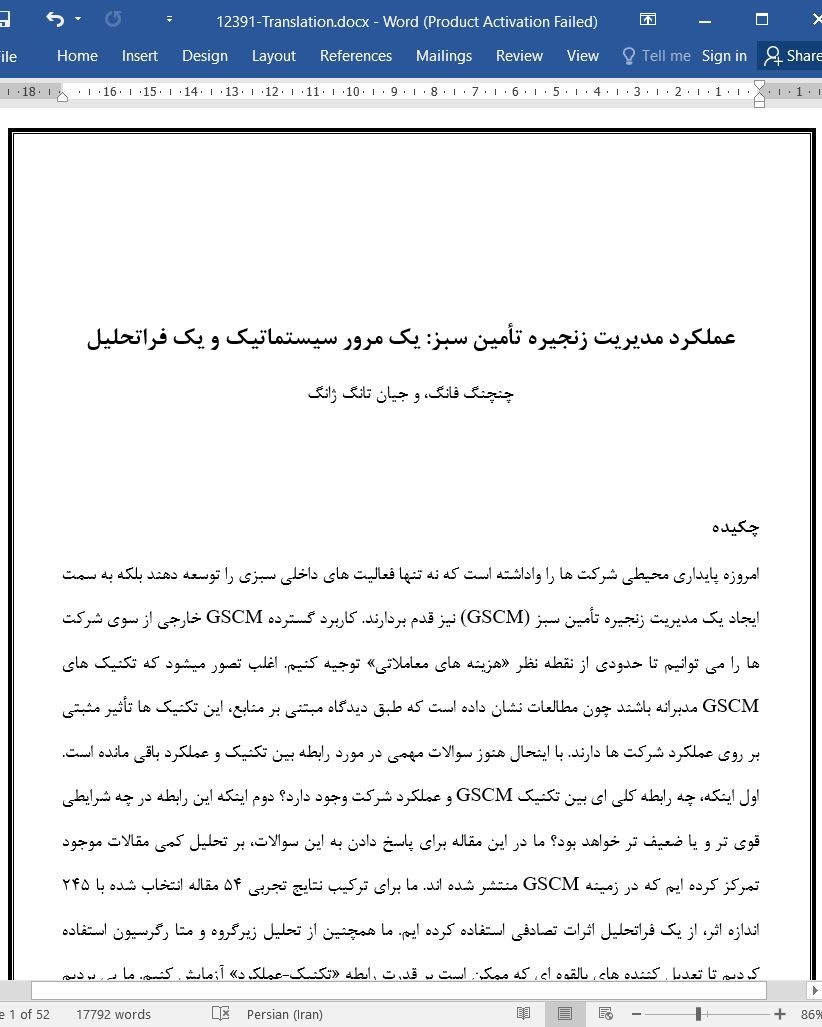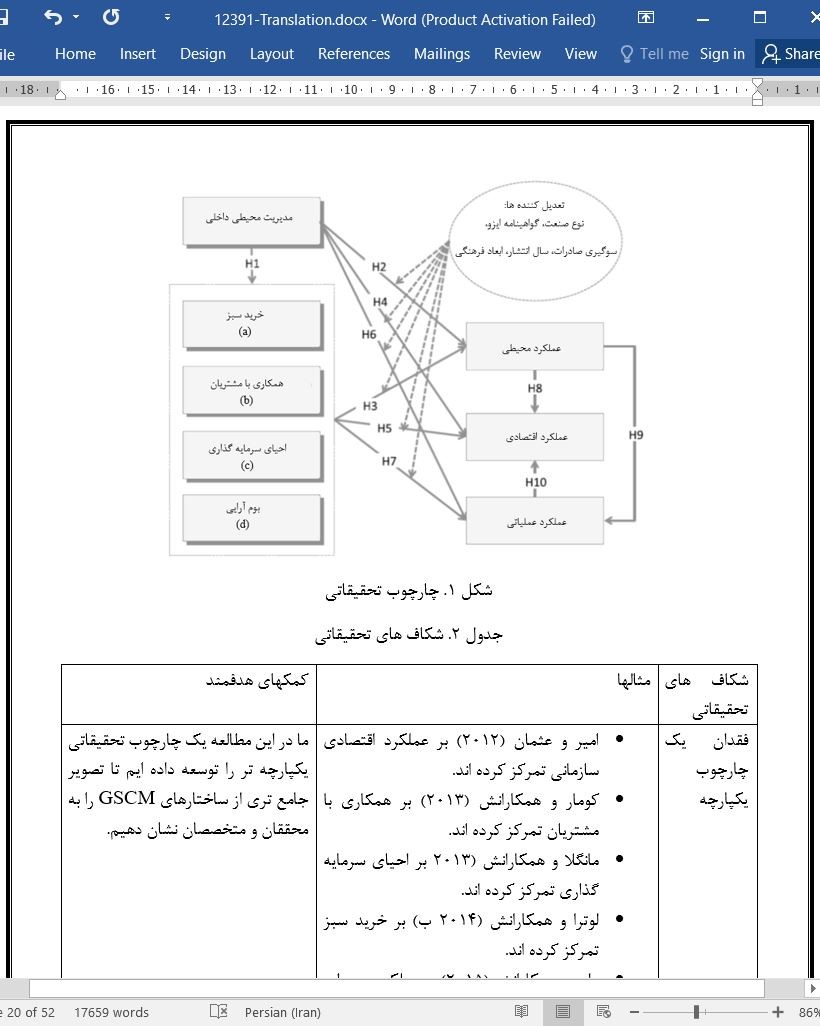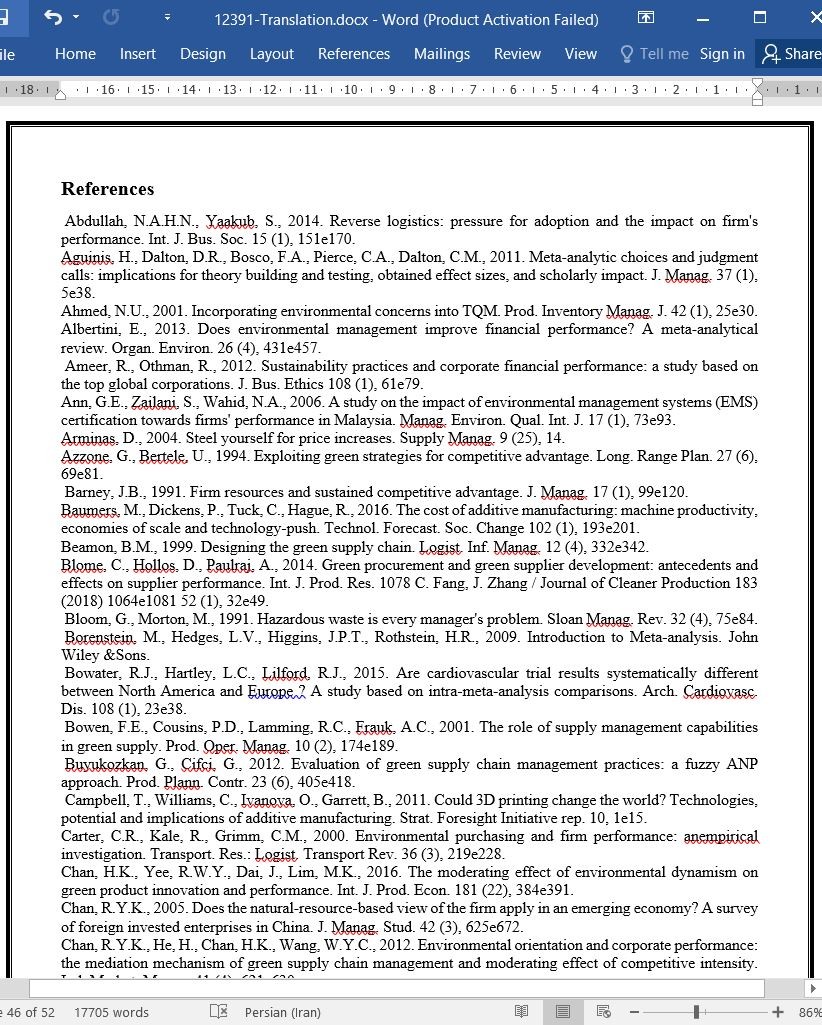
عملکرد مدیریت زنجیره تامین سبز: یک مرور سیستماتیک و یک فراتحلیل
چکیده
امروزه پایداری محیطی شرکت ها را واداشته است که نه تنها فعالیت های داخلی سبزی را توسعه دهند بلکه به سمت ایجاد یک مدیریت زنجیره تأمین سبز (GSCM) نیز قدم بردارند. کاربرد گسترده GSCM خارجی از سوی شرکت ها را می توانیم تا حدودی از نقطه نظر «هزینه های معاملاتی» توجیه کنیم. اغلب تصور میشود که تکنیک های GSCM مدبرانه باشند چون مطالعات نشان داده است که طبق دیدگاه مبتنی بر منابع، این تکنیک ها تأثیر مثبتی بر روی عملکرد شرکت ها دارند. با اینحال هنوز سوالات مهمی در مورد رابطه بین تکنیک و عملکرد باقی مانده است. اول اینکه، چه رابطه کلی ای بین تکنیک GSCM و عملکرد شرکت وجود دارد؟ دوم اینکه این رابطه در چه شرایطی قوی تر و یا ضعیف تر خواهد بود؟ ما در این مقاله برای پاسخ دادن به این سوالات، بر تحلیل کمی مقالات موجود تمرکز کرده ایم که در زمینه GSCM منتشر شده اند. ما برای ترکیب نتایج تجربی 54 مقاله انتخاب شده با 245 اندازه اثر، از یک فراتحلیل اثرات تصادفی استفاده کرده ایم. ما همچنین از تحلیل زیرگروه و متا رگرسیون استفاده کردیم تا تعدیل کننده های بالقوه ای که ممکن است بر قدرت رابطه «تکنیک-عملکرد» آزمایش کنیم. ما پی بردیم که تکنیک های GSCM داخلی و خارجی رابطه مثبتی با هم دارند، و در ضمن هر دوی آنها رابطه مثبتی با عملکرد شرکت دارند. خصوصاً رابطه آنها با عملکرد محیط (r=0.518) بزرگترین رابطه بود؛ بعد از عملکرد محیط، هم رابطه آنها بترتیب با عملکرد های عملیاتی (r=0.481) و اقتصادی (((r)0.464) روابط بزرگی بودند. آزمایش تعدیل کننده ها همچنین نشان داد که نوع صنعت، گواهینامه ایزو (ISO)، سوگیری صادراتی، و بُعد فرهنگی اجتناب از عدم اطمینان، همگی تأثیر تعدیل کننده ای بر روی رابطه «تکنیک-عملکرد» دارند. در آخر هم بحث ها و محدودیت های این مقاله را ارائه می دهیم.
1. مقدمه
این روزها مردم از تغییرات جوی و پایداری محیطی آگاه تر هستند (گزارش توسعه جهانی، 2015). افزایش رو به رشد نگرانی های سبز در بازارهای مصرف و همچنین فشار فزاینده از سوی مقررات دولتی، اکنون شرکت ها را وا می دارد که فعالیتهای روزانه خود را از یک دیدگاه بوم شناختی مدیریت کنند (ماتینگی و همکارانش 2014). امروزه شرکت ها در کسب و کار خود علاوه بر هزینه، زمان تدارک سفارش (زمان انجام کار) و کیفیت، باید بهبود عملکرد سبز را نیز – بعنوان یک اولویت رقابتی اساسی – مد نظر قرار دهند (بلوم و مورتون 1991؛ آزون و برتِل 1994). در سالهای قبل تر، شرکت ها بر ابزارهای سنجش داخلی سبز مانند کنترل آلودگی متمرکز بودند تا بتوانند تأثیر محیطی تولید (تولید محصولات) خود را کاهش دهند. اخیراً تکنیک های خارجی (همچون خرید سبز و بوم آرایی) هم بصورت گسترده اجرا می شوند چون اثبات شده است که بحران محیطی در شرکت های دیگر هم می تواند از طریق ایجاد اختلال در زنجیره تأمین، برای آنها زیان بخش باشد (کورت و کلاسن 2000). بنابراین مدیریت زنجیره تأمین سبز (GSCM) هم در متون آکادمی و هم در عمل بصورت یک موضوع مهم پدیدار شد؛ GSCM این را ایجاب می کرد که شرکت ها تفکر محیطی را به زنجیره تأمین کلی اضافه کنند (و آنرا مد نظر قرار دهند).
7. پیامدها (کاربردها) و محدودیت ها
مطالعه ما پیامدهای نظری مهمی دارد. اول اینکه، علیرغم این حقیقت که تحقیقات تجربی در زمینه GSCM با روشهای مختلفی انجام شده اند اما فراتحلیل ما آزمایش بسیاری از ساختارهای مجزا (که در عین حال با هم مرتبط نیز هستند) را ممکن می سازد تا شباهت ها یا تفاوت های بین آنها مشخص شود. این نوع تحلیل، فرصتی را برای ارزیابی مسان تر روابط بین ساختارها فراهم می سازد. دوم اینکه، ما در فراتحلیل خود طبقه بندی ای از تکنیک ها و عملکردها را شامل ساختیم که توسط مطالعات تجربی گسترده ای در زمینه GSCM اتخاذ شده است. طبقه بندی های کامل ما از تکنیک های سبز و همچنین عملکرد شرکت، بررسی رابطه آنها از یک دیدگاه یکپارچه تر را ممکن می سازد، که میتواند به کاهش شکاف بین «چیزهایی که پیشاپیش می دانیم» و «چیزهایی که باید بدانیم» کمک کند. سوم اینکه، ما تأثیرات چند تعدیل کننده بالقوه (همچون نوع صنعت، کواهینامه ایزو، و سوگیری صادرات) بر روی رابطه بین تکنیک های سبز و عملکرد شرکت را آزمایش کردیم تا بفهمیم که چه چیزهایی منجر به تفاوت های آنها در تحقیقات تجربی موجود می گردد. نتایج این آزمایش میتوانند به زمینه های اشاره کنند که در حین انجام مطالعه بر روی GSCM، نیازمند توجه بیشتری هستند؛ این نتایج بینش های مفیدی را در مورد توسعه نظریه های موجود (همچون نظریه مبتنی بر منابع) برای محققان فراهم می سازند تا این را توجیه کنند که چرا تکنیک های محیطی برای بعضی از شرکت ها یا صنایع، مؤثرتر هستند. و در نهایت اینکه، چون GSCM یک حوزه مطالعاتی نسبتاً جوان (جدید) است بنابراین احتمالاً فراتحلیل های زیادی در مورد آن منتشر نشده است. تحقیقات ما می تواند توضیحاتی را ارائه دهد و مانند منبعی برای رویکرد فراتحلیل برای تحقیقات دیگر در حوزه های مطالعات مشابه عمل کند و بنابراین به ترویج هر چه بیشتر «توسعه حوزه GSCM» کمک کند.
Abstract
Environmental sustainability is nowadays driving firms to not only develop internal green activities, but also extend toward green supply chain management (GSCM). The extensive application of external GSCM by firms can be partially justified from perspective of transaction costs. GSCM practices are often considered to be prudent because studies suggested that such practices have a positive impact on firm performance according to the resource-based view. However, crucial questions still surround the practice-performance relationship. First, what is the overall relationship between GSCM practice and firm performance? Second, under what situations is the relationship stronger or weaker? To answer these questions, this paper focuses on quantitatively analyzing extant literature published in the field of GSCM. A random-effects meta-analysis is used to synthesize the empirical results of 54 selected literature with 245 effect sizes. Besides, subgroup analysis and meta-regression are applied to test potential moderators that may influence the strength of practice-performance relationship. We find that, internal and external GSCM practices are positively related, and they are both positively related to firm performance. Particularly, their relationship with environmental (r = 0.518) performance is the largest, followed by operational (r = 0.481) and economic (r = 0.464) performance. In addition, test of moderators discovers that industry type, ISO certification, export orientation and the cultural dimension of uncertainty avoidance all have moderating effect on the practice-performance relationship. Discussions and limitations are further addressed.
1. Introduction
These days as never before, people are much more conscious of the climate change and environmental sustainability (World development report, 2015). The constantly increasing green concerns in consumer markets as well as rapidly growing pressure from governmental regulations are now driving companies to manage their daily activities from an ecological perspective (Mutingi et al., 2014). Besides the cost, lead-time and quality, firms today need to consider the improvement of green performance as a fundamental competitive priority when doing businesses (Bloom and Morton, 1991; Azzone and Bertele, 1994). In earlier years, firms focused on the internal green measurements such as pollution control to alleviate the environmental influence of their production. Recently, external practices (e.g., green purchasing and eco-design) have started to be widely implemented because they come to realize that the environmental crisis in other firms can also bring harm to them via disruptions along the supply chain (Corbett and Klassen, 2000). Therefore, green supply chain management (GSCM) has then emerged as an important topic in both academia and practice, which requires firms to integrate environmental thinking into the whole supply chain.
7. Implications and limitations
Our study has some important theoretical implications. First, in spite of the fact that empirical researches in GSCM are conducted in various methods, our meta-analysis allows for the test of many distinct but connected constructs to determine the similarities or differences among them. This type of analysis provides an opportunity for more consistent evaluation of links among constructs. Second, in our meta-analysis, we include a classification of both practices and performance, which has been most widely adopted by empirical studies about GSCM. Our detailed categorizations of green practices as well as firm performance enable an examination of their relationship from a more integrated perspective, which can help to diminish the gap between what we already know and what we need to know. Third, we tend to test the influences of several potential moderators (e.g., industry type, ISO certification and export orientation) on the relationship between green practices and firm performance in order to comprehend what leads to its difference in extant empirical investigations. The testing results can point to fields that need closer attention when upcoming studies are performed about GSCM, and provide researchers with helpful insights on the extension of existing theories (e.g., resource-based theory) to justify why environmental practices are more effective for certain firms or industries. Last but not least, because GSCM is a comparatively young study field, there are possibly not many metaanalyses published. Our research can offer an explanation and serve as a reference of the meta-analysis approach for other researches in similar study areas, thus helping to further promote the development of GSCM discipline.
چکیده
1. مقدمه
2. مروری بر تحقیقات پیشین و فرضیه ها
2.1 تکنیک های GSCM
2.2 عملکرد GSCM
2.2.1 عملکرد محیطی
2.2.2 عملکرد اقتصادی
2.2.3 عملکرد عملیاتی
2.2.4 روابط موجود با عملکرد
2.3 تعدیل کننده ها
2.3.1 تعدیل کننده های فرهنگی
2.3.2 تعدیل کننده های ماهوی
2.4 شکاف های (کمبودهای) تحقیقاتی
3. توسعه پایگاه داده
3.1 تعریف عبارات جستجوی مناسب
3.2 جستجوی مقالات اولیه
3.3 پالایش جستجوی اولیه
3.4 مجموعه داده نهایی
3.5 تحلیل داده
3.5.1 اندازه اثر
2.5.2 مدل آماری
3.5.3 اثر تعدیل کننده
3.5.4 تحلیل ناهمگنی
4. مرور سیستماتیک
5. فراتحلیل
5.1 تأثیر EM داخلی بر روی EM خارجی 11 پ اخر
5.2 تأثیر تکنیک های GSCM بر روی عملکرد شرکت
5.3 روابط موجود در بین (مؤلفه های) عملکرد
5.4 آزمایش تعدیل کننده ها
5.4.1 تحلیل زیرگروه
5.4.2 متا رگرسیون
6. نتیجه گیری
7. پیامدها (کاربردها) و محدودیت ها
منابع
Abstract
1. Introduction
2. Literature review and hypotheses
2.1. GSCM practices
2.2. Performance of GSCM
2.2.1. Environmental performance
2.2.2. Economic performance
2.2.3. Operational performance
2.2.4. Linkages among performance
2.3. Moderators
2.3.1. Cultural moderators
2.3.2. Substantive moderators
2.4. Research gaps
3. Database development
3.1. Definition of proper search terms
3.2. Initial literature search
3.3. Refinement of the initial search
3.4. Final dataset
3.5. Data analysis
3.5.1. Effect size
3.5.2. Statistical model
3.5.3. Moderating effect
3.5.4. Heterogeneity analysis
4. Systematic review
5. Meta-analysis
5.1. Impact of internal EM on external EM
5.2. Impact of GSCM practices on firm performance
5.3. Linkages among performance
5.4. Test of moderators
5.4.1. Subgroup analysis
5.4.2. Meta regression
6. Conclusion
7. Implications and limitations
References
- اصل مقاله انگلیسی با فرمت ورد (word) با قابلیت ویرایش
- ترجمه فارسی مقاله با فرمت ورد (word) با قابلیت ویرایش، بدون آرم سایت ای ترجمه
- ترجمه فارسی مقاله با فرمت pdf، بدون آرم سایت ای ترجمه



